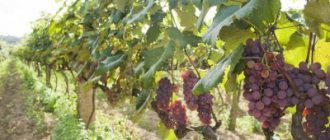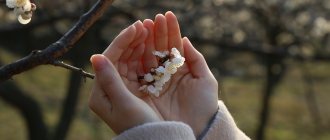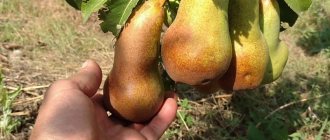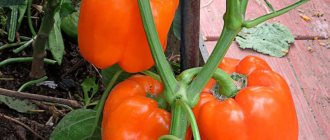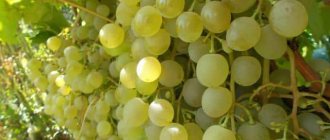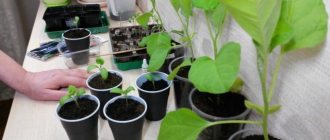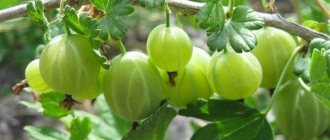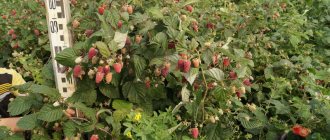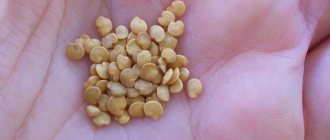History of selection
This magnificent early ripening variety was bred in 2004 at the Experimental Farm of the Artemovsk Research Station of Nursery Growing of the Institute of Horticulture of the National Academy of Agrosciences of Ukraine.
The variety was obtained by hybridizing the species D-54-82 (“Donchanka” and “Valery Chkalov”) and “Dzherelo” (“Drogana yellow” and “Valery Chkalov”). The work was supervised by the famous plant breeder L.I. Taranenko.
Variety Priusadnaya
Experts say that cherries appeared a long time ago, even before the various varieties of cherries.
As they say, it is useless to argue with them (there are no witnesses left anyway), the main thing is that nowadays people can enjoy excellent juicy fruits.
Today we will focus on the “Farewell” cherry, consider the description of the variety, the subtleties of agricultural technology and examples of the main pollinators.
History of selection
This magnificent early ripening variety was bred in 2004 at the Experimental Farm of the Artemovsk Research Station of Nursery Growing of the Institute of Horticulture of the National Academy of Agrosciences of Ukraine.
The variety was obtained by hybridizing species D-54-82 (“Donchanka” and “Valery Chkalov”) and “Dzherelo” (“Drogana yellow” and “Valery Chkalov”). The work was supervised by the famous plant breeder L.I. Taranenko.
Description of the tree
Cherry “Farewell” is a vigorous tree with a slightly spreading crown of a rounded or flat-round shape.
Sweet cherries are considered a type of cherry. Its name translated means “bird cherry”. The Farewell cherry is the largest and most delicious.
The variety was bred at the Artemovsk experimental station by crossing the hybrid form Donchanka and Valery Chkalov and the Dzherelo variety. The breeder L.I. successfully carried out the crossing. Taranenko.
The variety is winter-hardy.
Description of the variety
The tree is not a large plant. But its crown is very spreading and leafy. Plant size – up to 3-4 m in height. The leaves are oval-shaped, with jagged edges. The upper part is bright green, the lower part is lighter. The leaves are located on petioles up to 16 cm long.
Lat. Prunus avium
The flowers look like small white umbrellas that are very fragrant. They open at the end of March – beginning of April. The root rod is formed in the first two years, then it branches into horizontal and vertical skeletal branches.
The plant begins to bear fruit already in the 4-5th year of its life. The berries can be harvested in the second half of June. During the season you can collect more than 60 kg of fruits from one tree. The dark red berries are very large. The weight of one fruit can reach 14 grams. The bone comes off well. The pulp is dense, yellowish in color.
The taste can be described as dessert, even sweetish – wine-like. Up close you can feel a rich, pleasant aroma. Due to their dense peel, Proschalnaya cherry berries are easily transported.
In addition, the variety has other advantages:
- Drought resistance;
- Large fruit;
- High yield;
- Fruits of universal use.
Farewell cherries are consumed mainly fresh, rarely in the form of compotes and high-quality juices.
Farewell cherries are grown in forest-steppe and steppe regions of Ukraine. Favorable conditions for growing this species are:
- Light sandy soils have a neutral reaction. Calcareous soils are also suitable. Peat soil, sand or clay are soils that are least suitable for growing cherries;
- Sunny places, protected from cold winds;
- Groundwater should pass no closer than 1.5 m from the root system. Low-lying places where melt water stands for too long in the spring are not suitable for planting cherries;
For cross-pollination, Proschalnaya cherries require cherries of 2-3 other varieties. The most suitable species are Donetsk beauty, Drogana yellow, Yaroslavna, Valery Chkalov, Valeria, Annushka, Early pink.
Cherry yield in the garden
Farewell cherries are planted in the spring - if the process takes place in warm regions, and in the fall - if in the northern regions.
Before digging planting holes, you need to take into account that the rhizomes of an adult tree are located at a distance of 30-80 cm from the soil surface. The depth of vertical roots can reach two meters.
For this reason, the planting hole must be made at least 80 cm wide and 1 m deep.
If several plants are planted at the same time, it is necessary to provide a distance between them of at least 3-5 m. Planting too close will result in the spreading crown of adult plants shading neighboring trees.
How to plant cherries correctly? Let's take a closer look:
- Two weeks before planting the seedling, it is necessary to prepare the planting hole. One third of it must be covered with a soil mixture consisting of soil, ammonium sulfate, superphosphate, wood ash, and undiluted manure, which, if necessary, can be replaced with humus.
- If the soil is clayey, it needs to be diluted by adding 2 buckets of sand to the bottom of the hole. If the soil is sandy, on the contrary, add a couple of buckets of clay. Acidic soil is limed, and this must be done at least a week before applying fertilizer. After this, you can add soil mixture to the hole.
- At the bottom of the hole you need to install a support for the seedling, after which you can plant the tree, carefully straightening the roots.
- When the seedling is attached to the support, the soil is gradually added, lightly compacting it.
- The root collar of the tree should be left 3-4 cm above the surface.
- Finally, abundant watering and mulching are carried out. To do this, use humus, fallen leaves or peat.
Before planting a seedling in a hole, you need to remove dried roots, as well as those that do not fit in the hole. The roots of the plant are first placed in water for 2 hours. This time should be increased if the roots are very dry.
Plant care
Dimensions of Farewell cherries
The plant does not tolerate weeds, so you should regularly monitor the cleanliness of the soil near it. The diameter of the circle near the weed-free trunk should be at least 1 meter. This applies to plants in the second year after planting. Then, with each year of the plant’s life, this circle needs to be expanded by 30-50 cm.
The tree only needs three to five waterings during the season. To begin with, the tree trunk circle is well loosened, fertilizer is applied, and then watering is carried out. The soil is wetted until water penetrates to the depth of the roots of the seedling.
The plant is fed with slurry, which is taken in a ratio of 1:8, as well as an aqueous solution of ash in a ratio of 1:10. The fertilizer is poured not under the trunk itself, but onto the ground near it, previously cleared of weeds. This is important, since the near-trunk roots of the Farewell cherry are not sensitive to beneficial substances.
Feeding the plant should be enough for 3 years. After this period, the cherries are fed again. In mid-summer, the tree requires potassium and phosphorus fertilizers with the addition of microelements. In August you need organic matter: mullein or a solution of bird droppings.
Additionally, in early spring, 60-80 grams of urea are injected under the tree.
In the spring, before the buds swell, the tree is pruned, removing old dry branches. After this, the sections are treated with garden varnish. The procedure is carried out in order to increase productivity and improve the taste of berries. Pruning also reduces the likelihood of disease. Young seedlings begin to be pruned when they reach a height of 50-70 cm.
Mature cherry tree
To avoid cracking of the bark, the tree trunk is whitened in early spring and late autumn.
When the air is heated to 18 degrees, Farewell cherries must be sprayed against pathogens and pests. This is done using a urea solution.
Adult plants should not be covered for the winter if the tree trunk area is mulched and the trunk and bases of skeletal branches are whitened. It is better to wrap young cherries in burlap. You cannot use artificial materials for covering, as the plant will rot under them.
Farewell cherries are propagated by grafting or seeds.
Diseases
Phyllosticosis. The drug Nitrafen and Bordeaux mixture are used as treatment.
Small cherry seedling
Clusterosporiasis. Leaves, branches, shoots become covered with dark spots. The leaf plate crumbles and holes appear on it. This leads to leaf falling. The tissues on the shoots die, the fruits dry out. To combat, a solution of copper sulfate is used. The wounds on the plant are cleaned, the affected leaves are removed.
Gray rot. The plant's flowers dry up, its fruits rot, its branches dry out. For the purpose of treatment, the dead parts of the plant are removed, and the tree itself is treated with Bordeaux mixture.
Among the pests that are most dangerous for this type of cherry are the brown fruit mite. To get rid of it, you need to spray the plant with a 0.3% solution of karbofos.
We invite you to read: Sloe berry - benefits and harm to the body
Professional gardeners have some tricks that can be used to achieve high yields. Some of them:
- When the first flowers appear on the cherry tree, it can be regularly sprayed with honey solution - this will attract many bees, which will lead to good pollination. After this procedure, you can count on a higher yield;
- It is better to plant mustard with phacelia next to cherries. The plant is a good honey plant, which again attracts many bees;
- Planting various plants between the rows of Farewell cherries will protect the trees during severe frosts;
- When purchasing a seedling, you must carefully examine the trunk of the plant - there should be a mark from the grafting on it. This means that the plant is varietal, which in turn guarantees early fruiting and better taste; Formed cherry tree
- The more branches a seedling has, the easier it is to form the correct crown of a tree;
- The better the root system of the seedling, the better the plant will take root in open ground;
- Nitrogen fertilizers and lime should not be applied during the planting period, as they can cause burns to the root system of the plant.
Professional advice is useful and does not require much time and effort. If you follow these simple tips, Farewell cherries will delight their owners with a good harvest for many years.
While watching the video you will learn about caring for cherries.
According to reviews from professional gardeners, the variety is considered the best in Ukrainian selection. Its characteristics, as well as its taste, give every reason to believe that this is indeed the case.
- When the first flowers appear on the cherry tree, it can be regularly sprayed with honey solution - this will attract many bees, which will lead to good pollination. After this procedure, you can count on a higher yield;
- It is better to plant mustard with phacelia next to cherries. The plant is a good honey plant, which again attracts many bees;
- Planting various plants between the rows of Farewell cherries will protect the trees during severe frosts;
- When purchasing a seedling, you must carefully examine the trunk of the plant - there should be a mark from the grafting on it.
This means that the plant is varietal, which in turn guarantees early fruiting and better taste; Formed cherry tree (photo) - The more branches a seedling has, the easier it is to form the correct crown of a tree;
- The better the root system of the seedling, the faster the plant will take root in open ground;
- Nitrogen fertilizers and lime should not be applied during the planting period, as they can cause burns to the root system of the plant.
Noticed a mistake? Select it and press Ctrl Enter to let us know.
Attention, super FLIGHT!
- When the first flowers appear on the cherry tree, it can be regularly sprayed with honey solution - this will attract many bees, which will lead to good pollination. After this procedure, you can count on a higher yield;
- It is better to plant mustard with phacelia next to cherries. The plant is a good honey plant, which again attracts many bees;
- Planting various plants between the rows of Farewell cherries will protect the trees during severe frosts;
- When purchasing a seedling, you must carefully examine the trunk of the plant - there should be a mark from the grafting on it. This means that the plant is varietal, which in turn guarantees early fruiting and better taste;
Pollination
The tree is not self-fertile, so when growing, it is necessary to ensure that the tree has the right neighbors:
- "Donetsk coal";
- "Ethics";
- "Drogana yellow";
- "Valery Chkalov";
- "Donetskaya Yaroslavna";
- "Annushka";
- "Donchanka";
- "Sister";
- "Donetsk beauty";
- "Early pink";
- "Aelita";
- "Valeria".
Advantages and disadvantages
A description of any culture will be incomplete without highlighting all the main advantages and noting the disadvantages.
pros
The advantages of “Farewell” cherries include the following qualities:
- Large fruit.
- High yield.
- The versatility of the fruit's purpose.
- Undemanding to growing conditions.
- High drought resistance.
- Good type of fruiting.
Minuses
The disadvantages (one might even say minor weaknesses) include:
- Average resistance to fungal diseases.
- Non-self-fertility (required presence of neighboring pollinators).
Whatever tree you choose for your garden, you still have to make the decision. Only in this case it is worth considering that the description of the variety will be more consistent with reality with proper care and due attention to the tree. Then you will get incredible pleasure from juicy berries.
Plant care
The diameter of the circle near the weed-free trunk should be at least 1 meter. This applies to plants in the second year after planting. Then, with each year of the plant’s life, this circle needs to be expanded by 30-50 cm.
The tree only needs three to five waterings during the season. To begin with, the tree trunk circle is well loosened, fertilizer is applied, and then watering is carried out.
The soil is wetted until water penetrates to the depth of the roots of the seedling.
The plant is fed with slurry, which is taken in a ratio of 1:8, as well as an aqueous solution of ash in a ratio of 1:10. The fertilizer is poured not under the trunk itself, but onto the ground near it, previously cleared of weeds.
This is important, since the near-trunk roots of the described cherry are not sensitive to useful substances.
In the spring, before the buds swell, the tree is pruned, removing old dry branches. After this, the sections are treated with garden varnish. The procedure is carried out in order to increase productivity and improve the taste of berries.
We invite you to familiarize yourself with: Real Colonel cucumbers - characteristics and description of the variety
Pruning also reduces the likelihood of disease. Young seedlings begin to be pruned when they reach a height of 50-70 cm.
Starting from the 5th year of life, pruning is used to maintain the height of the tree at 3-3.5 m. If you prune a tree in the fall, it is better to do it before the end of September.
It is better to carry out autumn pruning using a saw, since after this the cuts heal faster and easier. Annual seedlings are not pruned in the fall; this can lead to the death of the tree in winter.
The Franz Josef cherry variety is widespread in the West and Central Russia. Suitable for growing in the Moscow region. Very well adapted to the steppe climate. The fruit tree is vigorous, the crown is not dense, round and tall.
The harvest is obtained in the 5th year from the moment the seedling is planted. An average of 50 kg can be harvested from an adult tree. The variety is mid-early and ripens in the second half of June.
The color of the fruits of the Franz Joseph variety is yellow, pink-red on one side. The pulp is dense and fleshy. The form is large, reaches 8-10 g. The taste is honey, there is practically no sourness. The fruits are well transported and can be stored in cool conditions for up to 8 days. Cherries are suitable for canning and retain their shape well.
Positive qualities of the variety:
- Good survival in drought and frost conditions.
- High yield.
- Excellent keeping quality.
- Sweet, juicy taste.
- Large fruits, good consumer qualities.
- There is no self-pollination.
- Strong growth.
Sweet cherries are well adapted to bad weather conditions and are popular in Central Asia due to their resistance to drought.

